10 November 2023 : The Hindu Editorial Notes PDF
The Hindu Editorial
10-November-2023
1. Women in red: On an optimum menstrual hygiene policy.
Topic: GS3 – Woman health.
Judicial Intervention:
- The Supreme Court of India intervenes, setting a four-week deadline for the government to finalize a comprehensive menstrual hygiene policy.
- Chief Justice D.Y. Chandrachud directs the formulation of a national model for girls’ toilet facilities in government-aided and residential schools.
Historical Context:
- Despite over three-quarters of a century post-Independence, India is now closest to establishing a menstrual hygiene policy.
- The delay prompts the judiciary to intervene, highlighting the need for a structured approach.
Access and Affordability:
- Menstrual hygiene products are more accessible due to advancements and urbanization.
- Affordability remains a challenge, particularly hindering women in semi-urban and rural areas.
NFHS Insights:
- According to the National Family Health Survey-5 (NFHS), 73% of rural women and 90% of urban women use hygienic methods.
- Improvement seen in the percentage of women aged 15-24 using hygienic methods, rising from 58% in NFHS-4 to 78% in NFHS-5.
- Link established between education and hygiene preference; women with 12 or more years of schooling are more likely to use hygienic methods.
Challenges Faced:
- Menstruation-related stigma leads to school dropouts.
- Limited access to sanitation facilities exacerbates the problem.
Government Response:
- The Centre informs the Court of a circulated draft policy, set to be finalized in four weeks.
- Emphasis on the importance of not just a policy but also ensuring access to affordable products, clean toilets, and water.
- The policy should address the entire lifecycle of menstruation, considering health and social consequences.
- A plea for the government to commit to serving the holistic needs of India’s women.
Conclusion
The Supreme Court’s intervention is a welcome step, and it is now up to the government to deliver on its promises. A comprehensive menstrual hygiene policy is essential to ensure the health and well-being of millions of women in India.
Question: Discuss the recent judicial intervention regarding menstrual hygiene policies in India. Evaluate the significance of these directives in addressing challenges related to menstrual hygiene, and access to sanitation in the country.
2. Acknowledge India’s economic successes too.
Topic: GS3 – Indian economy.
Indian Economy Post-COVID-19:
- In FY2023, the Indian economy grew at an impressive YoY rate of 7.2%, the fastest among major economies.
- IMF projects India’s YoY growth at 6.3% in FY2024, maintaining its position as the fastest-growing major economy.
- India, currently the fifth-largest economy globally, is projected to become the third-largest by 2027.
- The term “major economy” indicates India’s high growth not attributable to its small size.
Challenges and Resilience:
- Despite uneven external demand growth, India’s robust domestic demand contributes significantly to its economic growth.
- Affordability issues persist, especially in semi-urban and rural areas, impacting access to menstrual hygiene products.
Post-COVID Growth and Criticisms:
- Some contest the ‘fastest-growing’ label, suggesting the use of compound annual growth rates (CAGR) pre-COVID-19 for a fair assessment.
- YoY growth rates reflect progress despite the pandemic, comprising recovery from the pandemic’s economic impact.
- Present economic success is rooted in steps taken to mitigate pre-COVID-19 economic challenges.
- Measures since 2014, including calibrated liberalization, Insolvency and Bankruptcy Code (IBC), demonetization, Goods and Services Taxes (GST), and corporate tax rate reduction, have positively impacted the economy.
Capex Initiatives and Private Investment:
- In FY22, the government initiated a large Capex program to boost infrastructure.
- Central government Capex increased from 1.6% of GDP in FY19 to 2.7% in FY23, further budgeted to rise to 3.3% in FY24.
- The focus is on “crowding-in” private corporate investment, resulting in a significant rise in private corporate investment in FY23.
Inclusive Growth and Poverty Alleviation:
- Government initiatives, including Sabka Saath Sabka Vikas, focus on inclusive growth, poverty alleviation, livelihood enhancement, skill development, and women’s empowerment.
- NITI Aayog’s recent report highlights a remarkable decline in multidimensional poverty in India.
- Between 2015-16 and 2019-21, approximately 13.5 crore Indians escaped multidimensional poverty, with rural areas driving the decline.
- Rural living standards have seen tangible progress, with improved access to electricity, drinking water sources, and health insurance schemes.
Agricultural Growth and Nutritional Improvement:
- Government support for agriculture has led to unprecedented growth rates in fruits, vegetables, dairy, livestock products, and fisheries.
- Fruits and vegetables now constitute 19.4% of the food basket, and livestock products account for about 38% of the total value of agri-food.
- The country’s food basket is more nutritious, with a positive impact on public health.
Conclusion:
- India is aware of the long road ahead to achieve high-income status and a high quality of life for a majority of its citizens.
- However, the steadily rising aspirations of citizens are being matched by their belief that those aspirations will be realised in their lifetime.
3. As incentives for semiconductors sputter, course corrections are due
Topic: GS3 – Indian economy.
Under-Utilized PLI Funds for Semiconductors:
- PLI funds for manufacturing semiconductors remain under-utilized by more than 80%.
- The government’s expenditure on semiconductor fabrication capabilities must be clearly justified.
Discrepancy in PLI Schemes:
- PLI scheme for IT hardware has a ₹17,000 crore outlay, while the one for semiconductors and displays has ₹38,601 crore earmarked.
- The existing schemes demonstrate little promise in terms of employment and value addition.
Challenges with Semiconductor Manufacturing:
- Semiconductor production relies on advanced and automated systems, employing few people relative to the value generated in sales.
- Domestic employment outcomes are not guaranteed, even with optimal PLI benefits.
Global Supply Chain Factors:
- The success of these schemes depends on attracting an “ecosystem” to increase India’s electronics manufacturing sector’s value addition.
- Global manufacturing giants may not bypass the benefits of a globally distributed supply chain.
Need for a Tangible Outcome:
- Efforts should be made to encourage semiconductor design talent domestically.
- The focus remains on assembly and subsidizing large manufacturing plants, with imported raw and intermediate materials.
- Clarity on desired outcomes is essential to assess the impact and make necessary adjustments before substantial PLI spending occurs.
For Enquiry

10 November 2023 : The Hindu Editorial Notes PDF

10 Nov 2023 : Indian Express

10 November 2023 : Daily Current Affairs

Emergency Provisions

9 Nov 2023 : Daily Quiz

9 Nov 2023 : Daily Answer Writing

9 Nov 2023 : Indian Express

9 Nov 2023 : PIB

9 November 2023 : Daily Current Affairs

9 November 2023 : The Hindu Editorial Notes PDF
November 2023 The Hindu 10 November 2023 : The Hindu Editorial Notes PDF The Hindu Editorial
9-November-2023
1. An under-discussed facet of colonial history.
Topic: GS3 –…
Indian Express 10 Nov 2023 : Indian Express Indian Express
10-November-2023
1) India, US and the AI bridge
Context:
The need for a more thorough…
Daily Current Affairs 10 November 2023 : Daily Current Affairs Daily Current Affairs
10-November-2023
1) 100,000 GALAXIES IN A SINGLE FRAME: THE PROMISE OF EUCLID
Topic:…
Polity Emergency Provisions In Indian polity, Emergency refers to a situation where the Central executive exercises extraordinary…
Daily Quiz 9 Nov 2023 : Daily Quiz 9 Nov 2023 : Daily Quiz…
mains answer writing 9 Nov 2023 : Daily Answer Writing Mains Answer Writing
9-November-2023
1. The doctrine of Parliamentary sovereignty and judicial supremacy…
Indian Express 9 Nov 2023 : Indian Express Indian Express
9-November-2023
1) A matter of integrity
Context:
India celebrated its liberation…
November 2023 PIB 9 Nov 2023 : PIB PRESS INFORMATION BUREAU
9-November -2023
1. PM hails rise in patent applications in India.
Topic:…
Daily Current Affairs 9 November 2023 : Daily Current Affairs Daily Current Affairs
9-November-2023
1. Kerala moves SC against Governor again.
Topic: GS2 –…
November 2023 The Hindu 9 November 2023 : The Hindu Editorial Notes PDF The Hindu Editorial
9-November-2023
1. An under-discussed facet of colonial history.
Topic: GS3 –…


